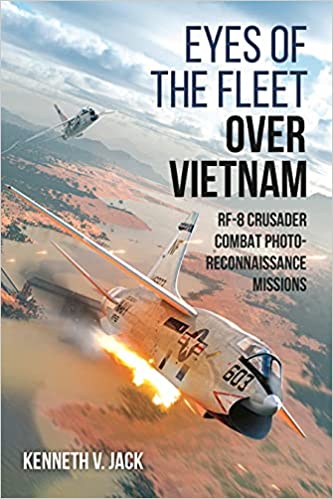Reviewed by ISCM (AW) David Mattingly, USN Ret.
A mix of airframes; fighters, light attack planes, and helicopters all made up the carrier air wings on Yankee Station during the Vietnam War. Most notably, the RF-8 Crusader piloted by Navy and Marine Corps aviators flew over enemy territory as the “eyes of the fleet.” Kenneth Jack, a Navy photographers mate assigned to Navy Light Photographic Squadron 62 (VFP-62), has gathered the story of the RF-8, its pilots, and maintainers from unofficial and official sources including reels of archived reconnaissance film shot over North Vietnam by RF-8 photo pilots.
The RF-8 Crusader was developed from the F-8 Crusader which entered the fleet in the mid-1950s and was the state-of-the-art fleet fighter until replaced by the F-4 Phantom II. Jack explains early in the book that “…the photographic reconnaissance squadrons were unique in a carrier air wing. They did not bring death and destruction to the enemy. At least not directly.” Photo reconnaissance aircraft acted as the collection platform to obtain clear imagery for the photo interpreters assigned to the squadron and the carrier intelligence center (CVIC). To become a photo pilot, the aviator needed the skills of a pilot to fly the F-8 plus the additional skill of flying the RF-8 over enemy territory straight and level to document the targets both pre and post bombing to judge the effectiveness of the bombing mission and to develop targets of opportunity for the airwing.
Before the Tonkin Gulf Incident in 1964 and Congress’s approval of the Tonkin Gulf Resolution, the Navy’s carrier air wings did not overfly North Vietnam except for RF-8s with their fighter escorts. It would be a reconnaissance mission flown by VFP-63 that located the first Soviet-built SA-2 Guideline surface-to-air missile site near Hanoi. This would have a tremendous impact on US tactics for flying missions in North Vietnam. Instead of flying at 10,000 feet to avoid ground-to-air artillery once SA-2s were identified, pilots began flying at 150-200 feet altitude and 600 knots (1.2 knots). Navy LT Roger Crim, flying from the USS Midway VFP-63 Det L explained, “I always thought that the reason enemy gunners got so close to me was a landline. Someone saw us and called ahead. My tactic was to be hidden from view, not coming around a hill into view of the gunners, until quite close in.”
However, tactics alone would not keep the RF-8s safe from guns and missiles. RF-8s were being hit, resulting in the loss of both pilots and aircraft. Jack quotes LCDR Scott Ruby, who flew off both USS Ranger and USS Midway, and said, “VFP-63 was losing …due to the stupidity of the ‘Rules of Engagement’ on how we should be used.” Ruby held the distinction of being the only pilot that did not get hit.
Jack uses historical essays by the Navy’s History and Heritage Command to explain the command structure of the Navy’s air wings flying over Vietnam. In the discussion, Dr. Mark Jacobsen stated that “target lists issued by CINCPAC and JCS did not include those targets for which targeting materials had been produced by [tactical commanders].” This would mean that the RF-8s were used for bomb damage assessment (BDA) of Navy missions. BDA was based on a comparison of pre and post photographs to determine the effectiveness of the bombing and whether a target needed to be restruck.
Throughout the book, pages are spaced within the pages that tell stories in memoriam of the RF-8 and its pilots. Besides the pilots that were killed in action, five VFP-63 pilots were shot down and held as prisoners of war in Hanoi. Jack includes a detailed story of LCDR Gordon Paige’s shootdown and capture. Paige’s story realistically places the reader amid the mission, recreates the feelings of an aviator flying a dangerous mission over North Vietnam, and recounts the tragedy of being shot down and captured. Paige would eventually be released after the 1973 Paris Peace Accords.
In addition to the Navy and Marine Corps aviators, VFP-63 also hosted a USAF exchange pilot, Capt. Jim “Mugs” Morgan. Morgan flew the US Air Forces RF-4C and had one combat tour before joining the VFP-63 Det on the USS Midway.
As the Vietnam War came to an end, so did the active-duty RF-8 squadrons. The RF-8s would continue to be flown in the Naval Air Reserve and some foreign militaries. Jack has created a very detailed account that will be of interest to military and aviation historians. He has ensured that memories of the men lost in Vietnam will continue to be told. Eyes of the Fleet Over Vietnam is highly recommended and deserves to be on every “brown shoes” bookshelf.
Master Chief Mattingly retired with over 30 years of service in the Navy. He also served as a Senior Intelligence Officer and Senior Research Analyst in the US Intelligence Community.
Eyes of the Fleet Over Vietnam: RF-8 Crusader Combat Photo-Reconnaissance Missions. By Kenneth V. Jack (Havertown, PA: Casemate, 2021).


